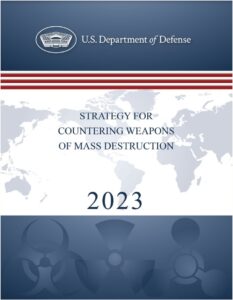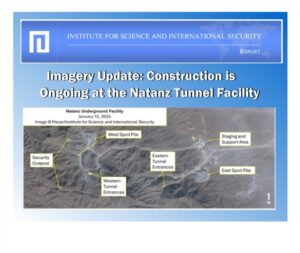US: Tehran can make nuclear bomb in less than two weeks
DOD REPORT LINK SCROLL DOWN
 Iran has the infrastructure in place and the know-how to make a nuclear weapon in less than two weeks, according to the U.S. Department of Defense’s 2023 Strategy for Countering Weapons of Mass Destruction report.
Iran has the infrastructure in place and the know-how to make a nuclear weapon in less than two weeks, according to the U.S. Department of Defense’s 2023 Strategy for Countering Weapons of Mass Destruction report.
“It is assessed that Iran is not pursuing a nuclear weapons program at
this time, but has the capacity to produce enough fissile material for a nuclear device in less than two weeks,” said the report, which outlines Washington’s strategic approach to countering the proliferation of weapons of mass destruction globally.
“Further, the United States assesses Iran to be noncompliant with its CWC [Chemical Weapons Convention] obligations. For example, Iran has not submitted a complete chemical weapons production facility declaration to comply with CWC processes. The United States is also concerned that Iran is pursuing dual-use central nervous system-acting chemicals for offensive purposes,” added the report.
Last month, Iran barred International Atomic Energy Agency inspectors from overseeing its nuclear activities.
“I strongly condemn this disproportionate and unprecedented unilateral measure,” said IAEA Director Rafael Grossi at the time. “With today’s decision, Iran has effectively removed about one-third of the core group of the agency’s most experienced inspectors designated for Iran.”
Tehran’s move came in response to a warning issued by the United States, Britain, France and Germany (the E3) at the IAEA’s Board of Governors.
The three countries warned that the Board will take further action if the Islamic Republic doesn’t comply with previous IAEA resolutions demanding that it explain highly enriched uranium particles found at various locations in Iran.
“Today, the world is seeing—and I will certainly emphasize this—that Iran is violating all of its commitments, that it brazenly lies, and that it intends both to develop nuclear weapons and continue its aggression in the region,” Israeli Prime Minister Benjamin Netanyahu said before his departure last month to address the U.N. General Assembly in New York.
Iran’s move also comes after U.S. Secretary of State Antony Blinken signed off on sanctions waivers paving the way for international banks to unfreeze $6 billion in Iranian funds.
Israeli National Security Adviser Tzachi Hanegbi last month warned that Jerusalem will have no choice but to act if Iran enriches uranium above 60%.
“If Iran moves to enrich uranium above 60% and we identify it—and there is no possibility that we won’t, that the world would not recognize it—the result is that Israel would act out of necessity,” he said. “There would be no choice.”
Such a development would indicate that “Iran is clearly pursuing a [nuclear] bomb, as a policy, and we cannot risk our fate,” added Hanegbi, without specifying how Israel would respond.
Earlier this year, IAEA inspectors detected “particles” of uranium enriched to 83.7% at Iran’s underground nuclear site in Fordow.
At the time, reports quoted an unnamed Israeli official as saying that Jerusalem did not consider the development a trigger for military action, because Tehran had not amassed any material “at that level.”
Iran has been enriching uranium to 60% since April 2021.
The latest IAEA report showed that Tehran has continued to amass uranium enriched to near weapons-grade levels. The report pegged the Islamic Republic’s stockpile of uranium enriched to 60% at 121.6 kilograms (268 pounds), compared to 114 kilograms (250 pounds) in May and 87.5 kilograms (192 pounds) in February.
Uranium enriched to 60% purity is a short technical step away from 90%, considered weapons-grade.
EXECUTIVE SUMMARY The 2023 Department of Defense (DoD) Countering Weapons of Mass Destruction (CWMD) Strategy outlines the Department’s guidance and approach to addressing the pursuit, development, and use of weapons of mass destruction (WMD). The Strategy accounts for the Department’s priorities and approach to integrated deterrence set forth in the 2022 National Defense Strategy (NDS) and addresses the current and future security environment, including the pacing challenge posed by the People’s Republic of China (PRC) and the acute threat posed by the Russian Federation. The ability of both the PRC and Russia to procure, develop, and deliver WMD has progressed since the release of the previous DoD CWMD Strategy in 2014, which focused on counterterrorism and counterinsurgency operations and managing risks emanating from hostile, fragile, or failed states and safe havens.




